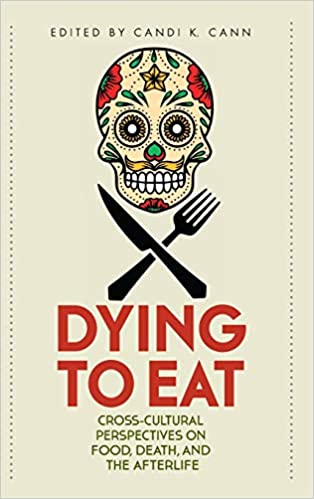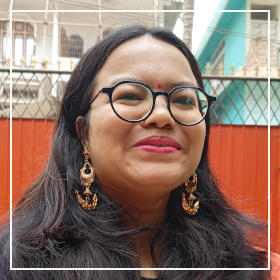 Dying to Eat: Cross-Cultural Perspectives on Food, Death, and the Afterlife (2018), edited by Candi K. Cann, is an interdisciplinary study that cuts across various approaches, including the anthropological, religious and ecological, to explore the relationship between food and death (pp. 1). The use of rich and textured materials such as images and detailed recipes makes the book captivating.
Dying to Eat: Cross-Cultural Perspectives on Food, Death, and the Afterlife (2018), edited by Candi K. Cann, is an interdisciplinary study that cuts across various approaches, including the anthropological, religious and ecological, to explore the relationship between food and death (pp. 1). The use of rich and textured materials such as images and detailed recipes makes the book captivating.
The book’s scope is vast, as the authors examine the relationship between food and death, drawing on examples from China, Korea, America, Mexico, Morocco and South Africa. This geographical diversity drives home the argument that food and death are interrelated worldwide. This argument is worth pondering over when scholarly discussions of the link between sustainability, nourishment and inequality have gained renewed attention due to the COVID-19 pandemic (Belik 2020). These deliberations have highlighted the global aspects of these issues and the need for a diverse and interdisciplinary approach, like the one used in Dying to Eat.
The book is divided into two parts – Dining with the Dead and Eating After: Food and Drink in Bereavement and Remembrance. The first section builds on examples from China, Korea, Mexico, and the United States to explore food’s role in mediating between the living and the dead, enriching the existing literature on this topic. The second part looks at the role food plays in remembering the dead. Drawing on examples from Latin American, Morocco and South Africa, these chapters explore how food is used to maintain and negotiate social relationships after the deceased have left.
Food is used to maintain and negotiate social relationships after the deceased have left.
Similar studies have been carried out in the past. Social anthropologists like M. N. Srinivas have looked at how mourners offer food to the deceased person’s spirit every day until the purification ritual is performed amongst the Hindus in Coorg (Srinivas 1952). This food offering functions as a mediating agent between the dead and the living. Thus, when one reads Dying to Eat, it is interesting for the reader to relate it to existing anthropological works on food and death.
In this review, I will look at specific chapters from each section of the book to discuss how the contributors explore the association between food and death. Food has social, economic, cultural, political and religious meanings. It is also a mediating agent between life and death. As an integral part of death rituals, it helps the living to stay connected with the dead. Building upon such existing scholarship on food as a mediating agent between life and death, the chapters are illustrations more than radical reconceptualisations. For instance, Emily S. Wu looks at how, amongst Han Chinese communities, food offerings to ancestors help keep their memory alive and include them in the community. Maintaining the connection between the dead and the living after death is a rather widespread concern, as Jung Eun Sophia Park’s chapter also clarifies.
Building upon existing scholarship on food as a mediating agent between life and death, the chapters are illustrations more than radical reconceptualisations.
Park argues that amongst the Koreans she studies, performing ancestral worship is seen as one of the most important kinship duties. Food is an integral part of this ritual as descendants of the dead ancestor cook and eat together to pay their respect. Young San Jae is one of the most significant eating rituals for the dead. It traditionally takes place on June 6th, on the occasion of Kore’s Memorial Day. During this festival that involves singing, dancing, and food, the departed souls are ritually invited to eat food to ensure their social inclusion in the community.
Interestingly, certain types of food express the relationship between the living and the dead more than others. Drawing from the examples of China, Mexico and the United States, Candi K. Cann explores the role sugar, starch and wine play in remembering the dead. According to her, sugar – as found in foods like American Halloween candy, Mexican sugar skulls, Chinese wine and brown sugar funeral candy – is often used to lessen the pain of death (pp. 58).
Food is used to remember the dead, connect the dead and the living, and remind the living of their kinship duties. Certain foods like sugar and starch help the living mediate the pain of losing their close relatives and cope with their grief. Thus, specific dishes become known as ‘funeral foods’ – for example, the Maw Maw’s Chess Pie in the American South, which is gifted and prepared to help remember the dead. Similarly, it is customary to serve couscous amongst Muslims in Morocco after a family member passes away, as described by David Oualaalou. Gathering to eat couscous together helps remind everyone that mortality is a universal fact, and nobody can escape it.
Certain foods like sugar and starch help the living mediate the pain of losing their close relatives and cope with their grief. Thus, specific dishes become known as ‘funeral foods’.
Lacy Crocker and Gordon Fuller’s chapter shows that food plays a central role in remembering the dead and connecting the living with the world of the dead amongst Jewish communities. During the mourning period, food with round shapes like lentils and hard-boiled eggs are often prepared, as they symbolise the life cycle and the continuity between the living and the dead.
In most cultures, mourning rituals – including eating and drinking – happen in stages. These phases can be broadly divided into prefuneral, funeral, post-funeral and post-post funeral (pp. 174). Radikobo Ntsimane explores how the Tswana and the Zulu use food to mourn the dead in four stages. These phases consist of social feasts to which no formal invitations are extended, as they are open to all. It gives the poor and the hungry the chance to eat a good meal. In return, they pray for peace for both the departed and the living.
The gendered nature of bereavement and grief is also noticeable across cultures and communities, as described in multiple chapters. Women are often in charge of preparing the food for ancestral worship and remembrance, overseeing all the preparation work and paying particular attention to following the dietary law. For instance, Jewish women must prepare the food according to the kosher rules, although following these is not limited to mourning ceremonies (pp. 111). Many of the recipes and traditions are passed from one generation of women to another. The role of women in food preparation has been emphasised across anthropological literature. For instance, amongst the Hindus, women prepare food for all rituals and ceremonials, including death (Dube, 1998).
Dying to Eat argues that the relationship between food and death rituals is universal, although its cultural manifestations are different.
Dying to Eat argues that the relationship between food and death rituals is universal, although its cultural manifestations are different. However, the inclusion of one or two essays from European contexts would have enhanced the geographical diversity of the book. Although there is a chapter on Jews, the field site is not mentioned. It is not my argument that to be ‘global’ in nature must mean including every region. However, since the book looks at cross-cultural comparisons, the omission of Europe is disappointing as it reinforces the exoticisation of these rituals and customs by omitting to show how Europeans participate in similar traditions.
Similarly, although essays explore the role of food in Asia, there is no reference to India and Hinduism. The relationship between food and death throughout India has been widely studied in both sociological and anthropological literature. For instance, M. N. Srinivas, in his study of the Coorg, had illustrated how food was at the centre of death rituals amongst the Hindus as early as 1952. The mourning period is marked by the observance of certain food taboos like non-consumption of areca nut and betel leaves when a relative passes away (Srinivas 1952). Other contemporary works have also explored how food is an integral part of death rituals amongst Hindus. For instance, women’s role in cooking large amounts of food during death rituals and ceremonies was highlighted by Leela Dube (1998). Therefore, this omission can be considered a gap in the book’s scope as it refers to almost every other major religion.
Notwithstanding these drawbacks, the book is an essential contribution to anthropological theory building on the relationship between food and death. This book brings together a rare collection of interdisciplinary essays on the relationship between food and death that will be of interest to anthropologists and students willing to deepen their cross-cultural understandings of death rituals.
Wu, E., Park, J. E. S., Graham, J., Crocker, L. K., Fuller, G., Oualaalou, D., Shusko, C. & Ntsimane, R. (2018). Dying to Eat: Cross-cultural Perspectives on Food, Death, and the Afterlife. University Press of Kentucky.
References:
Belik, W. (2020). Sustainability and food security after COVID-19: Relocalizing food systems?. Agricultural and Food Economics. 8(23): https://doi.org/10.1186/s40100-020-00167-z.
Dube, Leela. (1998). On the Construction of Gender: Hindu Girls in Patrilineal India. Economic and Political Weekly. 23(18): WS11-WS19. Economic and Political Weekly.
Srinivas, M.N. (1952). Religion and Society Among the Coorgs of South India. Oxford: Clarendon Press.
Image: Altar de Día de Muertos en Actopan, Hidalgo, México (2016). Cropped, by RubeHM. Found on Wikimedia Commons, (CC BY-SA 4.0).



